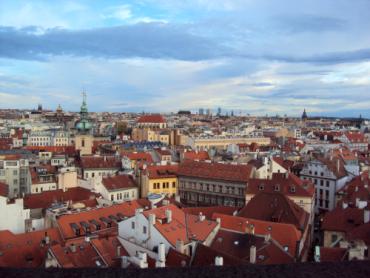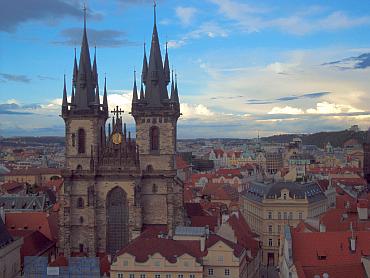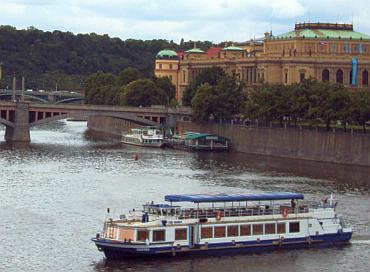 | « Back to article | Print this article |
Travel: On the banks of the Vlatva
Payal Mohanka discovers the medieval magnificence of Prague.
Prague does not let go,
Either of you or of me.
This little mother has claws.
There is nothing for it but to give in...'
Franz Kafka, Prague's most renowned literary son
Nestled in the heart of the Continent bridging western and eastern Europe, Prague bustles with palpable energy: Whether it is the tourists who throng the 12 century-old Town Square, one of the largest squares in Europe, to witness the 12 Apostles peek out of the window every hour, on the hour as the Astronomical Clock (1410) strikes or the locals who keep their shops open till 11 pm accepting both Euro and Czech Koruna as they indulge in friendly bargaining and ensure visitors walk out with their purchases and a smile.
Cloaked in medieval magnificence, the capital of the Czech Republic enthrals tourists with its magical charm. This city with its historic squares, terracotta roofs, spires and Gothic landscape evokes images of an era gone by.
Time has truly stood still. But now as Prague sheds its Communist past and rises to face the challenges of the present, it is all set to shine as the capital of one of the European Union's most vibrant members.
Travel: On the banks of the Vlatva
On the banks of the Vlatva river its vast number of historic landmarks give the city its hauteur. The Town Hall's observatory reflects the city's ancient heritage. The Old Town Square is the centre of Prague's eventful history with its Gothic, Renaissance and Baroque buildings. The historic centre which includes most of the city's major sites became a UNESCO-listed site in 1992.
One of the most enduring images of Prague is that of the Gothic twin steeples of Tyn Church, which frame the Old Town Square.
Another ideal spot to soak in the atmosphere of this unique city is the new square or Wenceslas Square: Local residents chat exuberantly, while shoppers crowd the chain stores that line the street.
Meander through the neighbouring maze of lanes and by lanes and you come across cafes and shops selling souvenirs: Bags and T-shirts (screaming I Love Praha), shops selling wooden Czech toys, the most popular being the babushka dolls, sets of wooden dolls of decreasing sizes placed one inside the other often modelled on international sports personalities, politicians and other celebrities.
Bohemia showrooms sell exquisitely crafted shimmering crystal decanters and wine glasses, while Blue has a vivid range of steeply priced but breathtakingly beautiful blown glass.
On the banks of the Vlatva
The Charles Bridge on the River Vlatva is one of the oldest bridges in Europe. With the 30 statues which adorn each side of the bridge, this is Prague's most well-known landmark. The bridge teems with a lively bustle of activity... Artist Ivan Pavlicek exhibits his innovative paintings on metal, while other artists do quick portraits of enthusiastic tourists.
The twilight sky offers a mesmerising view of Gothic spires across the river. On the other side of the bridge lies Mala Strana, where the imposing Baroque church of St Nicholas stands. The church was founded in1755.
A steep but pleasant walk from here leads to Hradcany, the city's original site. Dating back to the 10th century, Prague castle, officially the world's largest ancient castle, stands here in its majestic splendour. Its premier attractions: St Vitus Cathedral, the Royal Palace and the Golden Lane.
The Golden Land is an interesting part of the Prague Castle complex. Dating back to the 15th century, this small street is lined with 11 historic houses, which exhibit medieval armoury and textiles.
Travel: On the banks of the Vlatva
Our guide narrates stories from a bygone age. There is an audible gasp from the eager listeners as she talks about Defenestration: The act of throwing someone out of a window. This was the forcible removal of an adversary. The term originated from incidents in Prague's history. In 1618 two Imperial governors and their secretary were thrown from a window in Prague Castle triggering the Thirty Years War.
From Mala Strana, walk south down to Kampa Island for a stunning view of the Old Town from the river. A small island washed by the waters of the Vltava river on one side and the Devil's Stream on the other, Kampa is called the Venice of Prague. Relatively tranquil and uncrowded, Kampla island's English-style gardens are a perfect getaway from the teeming crowd of tourists in Prague.
A typical Czech meal comprises a large serving of roast meat, pork or beef, accompanied with hot cabbage and dumplings, rounded off with a glass of Czech beer or wine and ends with a very creamy fruity dessert. If this seems to be too calorific, there is also a wide range of lighter cuisine to choose from.
For those looking to grab a quick bite, the hot dogs from street kiosks are a favourite.
There are two main modes of transport in Prague -- the metro and tramcars. There are only three metro lines and their coverage is limited. The city's 900 trams and 34 lines on the other hand, snake through all the main points of interest and are a great way of seeing the city, besides walking.
As Kafka says it is not easy to wrench yourself away from this magical city. But finally we have to drive towards the airport. The friendly cabbie points out the domes and spires of his beloved Praha with justifiable pride. We whisper a wistful goodbye to this vivid tapestry of the past and the present, while the Czech rendition of Killing Me Softly plays on in the cab...



